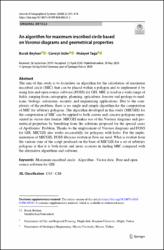| dc.contributor.author | Beyhan, Burak | |
| dc.contributor.author | Güler, Cüneyt | |
| dc.contributor.author | Taga, Hidayet | |
| dc.date.accessioned | 2020-11-20T14:39:26Z | |
| dc.date.available | 2020-11-20T14:39:26Z | |
| dc.date.issued | 2020 | |
| dc.identifier.issn | 1435-5930 | |
| dc.identifier.issn | 1435-5949 | |
| dc.identifier.uri | https://doi.org/10.1007/s10109-020-00325-3 | |
| dc.identifier.uri | https://hdl.handle.net/20.500.12809/433 | |
| dc.description | WOS: 000546380400005 | en_US |
| dc.description.abstract | The aim of this study is to formulate an algorithm for the calculation of maximum inscribed circle (MIC) that can be placed within a polygon and to implement it by using free and open source software (FOSS) for GIS. MIC is used in a wide range of fields, ranging from cartography, planning, agriculture, forestry and geology to medicine, biology, astronomy, security, and engineering applications. Due to the complexity of the problem, there is no single and simple algorithm for the computation of MIC for arbitrary polygons. The algorithm developed in this study (MICGIS) for the computation of MIC can be applied to both convex and concave polygons represented in vector data format. MICGIS makes use of the Voronoi diagrams and geometrical properties by benefiting from the solutions proposed for the special cases of Apollonius' Problem. Thanks to the employment of Voronoi diagrams and FOSS for GIS, MICGIS also works successfully for polygons with holes. For the implementation of MICGIS, FOSS libraries written in Java are used. What is evident from the various runs of the script produced on the base of MICGIS for a set of arbitrary polygons is that it is both faster and more accurate in finding MIC compared with the alternative algorithms and software. | en_US |
| dc.item-language.iso | eng | en_US |
| dc.publisher | Springer Heidelberg | en_US |
| dc.item-rights | info:eu-repo/semantics/closedAccess | en_US |
| dc.subject | Maximum Inscribed Circle | en_US |
| dc.subject | Algorithm | en_US |
| dc.subject | Vector Data | en_US |
| dc.subject | Free and Open Source Software For GIS | en_US |
| dc.title | An algorithm for maximum inscribed circle based on Voronoi diagrams and geometrical properties | en_US |
| dc.item-type | article | en_US |
| dc.contributor.department | MÜ, Mimarlık Fakültesi, Şehir Ve Bölge Planlama Bölümü | en_US |
| dc.contributor.institutionauthor | Beyhan, Burak | |
| dc.identifier.doi | 10.1007/s10109-020-00325-3 | |
| dc.identifier.volume | 22 | en_US |
| dc.identifier.issue | 3 | en_US |
| dc.identifier.startpage | 391 | en_US |
| dc.identifier.endpage | 418 | en_US |
| dc.relation.journal | Journal of Geographical Systems | en_US |
| dc.relation.publicationcategory | Makale - Uluslararası Hakemli Dergi - Kurum Öğretim Elemanı | en_US |


















